Differences in the Vertical Distribution of Aerosols, Nitrogen Dioxide, and Formaldehyde between Islands and Inland Areas: A Case Study in the Yangtze River Delta of China
Abstract
:1. Introduction
2. Materials and Methods
2.1. Observation Site
2.2. Spectral Analysis and DOAS Vertical Profile Retrieval
2.3. Potential Source Analysis
2.4. Ancillary Data
2.5. Data Verification
3. Results
3.1. Spatiotemporal Variations of AE, NO2, and HCHO
3.2. Vertical Profiles of Aerosols, NO2 and HCHO
4. Discussion
4.1. Diurnal and Weekly Variations of Aerosols, NO2, and HCHO
4.2. Differences in Potential Sources of Aerosols, NO2, and HCHO between Islands and Inland Areas
5. Conclusions
Supplementary Materials
Author Contributions
Funding
Data Availability Statement
Acknowledgments
Conflicts of Interest
References
- Xin, J.; Ma, Y.; Zhao, D.; Gong, C.; Ren, X.; Tang, G.; Xia, X.; Wang, Z.; Cao, J.; De Arellano, J.V.-G.; et al. The Feedback Effects of Aerosols from Different Sources on the Urban Boundary Layer in Beijing China. Environ. Pollut. 2023, 325, 121440. [Google Scholar] [CrossRef] [PubMed]
- Wu, S.; Tang, G.; Wang, Y.; Yang, Y.; Yao, D.; Zhao, W.; Gao, W.; Sun, J.; Wang, Y. Vertically Decreased VOC Concentration and Reactivity in the Planetary Boundary Layer in Winter over the North China Plain. Atmos. Res. 2020, 240, 104930. [Google Scholar] [CrossRef]
- Falah, S.; Kizel, F.; Banerjee, T.; Broday, D.M. Accounting for the Aerosol Type and Additional Satellite-Borne Aerosol Products Improves the Prediction of PM2.5 Concentrations. Environ. Pollut. 2023, 320, 121119. [Google Scholar] [CrossRef] [PubMed]
- Hossain, M.S.; Frey, H.C.; Louie, P.K.K.; Lau, A.K.H. Combined Effects of Increased O3 and Reduced NO2 Concentrations on Short-Term Air Pollution Health Risks in Hong Kong. Environ. Pollut. 2021, 270, 116280. [Google Scholar] [CrossRef]
- Tian, X.; Xie, P.; Xu, J.; Li, A.; Wang, Y.; Qin, M.; Hu, Z. Long-Term Observations of Tropospheric NO2, SO2 and HCHO by MAX-DOAS in Yangtze River Delta Area, China. J. Environ. Sci. 2018, 71, 207–221. [Google Scholar] [CrossRef]
- Ren, B.; Xie, P.; Xu, J.; Li, A.; Qin, M.; Hu, R.; Zhang, T.; Fan, G.; Tian, X.; Zhu, W.; et al. Vertical Characteristics of NO2 and HCHO, and the Ozone Formation Regimes in Hefei, China. Sci. Total Environ. 2022, 823, 153425. [Google Scholar] [CrossRef]
- Gao, Y.; Pan, H.; Cao, L.; Lu, C.; Yang, Q.; Lu, X.; Ding, H.; Li, S.; Zhao, T. Effects of Anthropogenic Emissions and Meteorological Conditions on Diurnal Variation of Formaldehyde (HCHO) in the Yangtze River Delta, China. Atmos. Pollut. Res. 2023, 14, 101779. [Google Scholar] [CrossRef]
- Xing, C.; Liu, C.; Hong, Q.; Liu, H.; Wu, H.; Lin, J.; Song, Y.; Chen, Y.; Liu, T.; Hu, Q.; et al. Vertical Distributions and Potential Sources of Wintertime Atmospheric Pollutants and the Corresponding Ozone Production on the Coast of Bohai Sea. J. Environ. Manag. 2022, 319, 115721. [Google Scholar] [CrossRef]
- Liu, C.; Xing, C.; Hu, Q.; Li, Q.; Liu, H.; Hong, Q.; Tan, W.; Ji, X.; Lin, H.; Lu, C.; et al. Ground-Based Hyperspectral Stereoscopic Remote Sensing Network: A Promising Strategy to Learn Coordinated Control of O3 and PM2.5 over China. Engineering 2022, 19, 71–83. [Google Scholar] [CrossRef]
- Zhang, Q.; Ma, X.; Tie, X.; Huang, M.; Zhao, C. Vertical Distributions of Aerosols under Different Weather Conditions: Analysis of in-Situ Aircraft Measurements in Beijing, China. Atmos. Environ. 2009, 43, 5526–5535. [Google Scholar] [CrossRef]
- Klein, A.; Ancellet, G.; Ravetta, F.; Thomas, J.L.; Pazmino, A. Characterizing the Seasonal Cycle and Vertical Structure of Ozone in Paris, France Using Four Years of Ground Based LIDAR Measurements in the Lowermost Troposphere. Atmos. Environ. 2017, 167, 603–615. [Google Scholar] [CrossRef]
- Zhang, K.; Xiu, G.; Zhou, L.; Bian, Q.; Duan, Y.; Fei, D.; Wang, D.; Fu, Q. Vertical Distribution of Volatile Organic Compounds within the Lower Troposphere in Late Spring of Shanghai. Atmos. Environ. 2018, 186, 150–157. [Google Scholar] [CrossRef]
- Luo, Y.; Dou, K.; Fan, G.; Huang, S.; Si, F.; Zhou, H.; Wang, Y.; Pei, C.; Tang, F.; Yang, D.; et al. Vertical Distributions of Tropospheric Formaldehyde, Nitrogen Dioxide, Ozone and Aerosol in Southern China by Ground-Based MAX-DOAS and LIDAR Measurements during PRIDE-GBA 2018 Campaign. Atmos. Environ. 2020, 226, 117384. [Google Scholar] [CrossRef]
- Tang, G.; Liu, Y.; Huang, X.; Wang, Y.; Hu, B.; Zhang, Y.; Song, T.; Li, X.; Wu, S.; Li, Q.; et al. Aggravated Ozone Pollution in the Strong Free Convection Boundary Layer. Sci. Total Environ. 2021, 788, 147740. [Google Scholar] [CrossRef] [PubMed]
- Lv, L.; Xiang, Y.; Zhang, T.; Chai, W.; Liu, W. Comprehensive Study of Regional Haze in the North China Plain with Synergistic Measurement from Multiple Mobile Vehicle-Based Lidars and a Lidar Network. Sci. Total Environ. 2020, 721, 137773. [Google Scholar] [CrossRef] [PubMed]
- Ou, J.; Hu, Q.; Liu, H.; Hong, Q.; Xing, C.; Tan, W.; Lin, H.; Wang, X.; Xu, H.; Zhu, P.; et al. Vertical Characterization and Potential Sources of Aerosols in Different Seasons over the Yangtze River Delta Using Ground-Based MAX-DOAS. Environ. Pollut. 2021, 279, 116898. [Google Scholar] [CrossRef]
- Lee, H.; Ryu, J.; Irie, H.; Jang, S.-H.; Park, J.; Choi, W.; Hong, H. Investigations of the Diurnal Variation of Vertical HCHO Profiles Based on MAX-DOAS Measurements in Beijing: Comparisons with OMI Vertical Column Data. Atmosphere 2015, 6, 1816–1832. [Google Scholar] [CrossRef]
- Zhang, J.; Chen, J.; Xia, X.; Che, H.; Fan, X.; Xie, Y.; Han, Z.; Chen, H.; Lu, D. Heavy Aerosol Loading over the Bohai Bay as Revealed by Ground and Satellite Remote Sensing. Atmos. Environ. 2016, 124, 252–261. [Google Scholar] [CrossRef]
- Hu, Q.; Liu, C.; Li, Q.; Liu, T.; Ji, X.; Zhu, Y.; Xing, C.; Liu, H.; Tan, W.; Gao, M. Vertical Profiles of the Transport Fluxes of Aerosol and Its Precursors between Beijing and Its Southwest Cities. Environ. Pollut. 2022, 312, 119988. [Google Scholar] [CrossRef]
- Ding, H.; Liu, Y.; Yu, Z.; Cheung, C.; Zhan, J. Spatial and Temporal Characteristics and Main Contributing Regions of High PM2.5 Pollution in Hong Kong. Aerosol Air Qual. Res. 2017, 17, 2955–2965. [Google Scholar] [CrossRef]
- Zhang, H.; Li, A.; Hu, Z.; Guo, J.; Yun, L.; Zhang, M.; Ren, H.; Zhong, H.; Xu, J. Evaluation and Measurement of Tropospheric Glyoxal Retrieved from MAX-DOAS in Shenzhen, China. Sci. Total Environ. 2023, 878, 162727. [Google Scholar] [CrossRef] [PubMed]
- Xu, S.; Wang, S.; Xia, M.; Lin, H.; Xing, C.; Ji, X.; Su, W.; Tan, W.; Liu, C.; Hu, Q. Observations by Ground-Based MAX-DOAS of the Vertical Characters of Winter Pollution and the Influencing Factors of HONO Generation in Shanghai, China. Remote Sens. 2021, 13, 3518. [Google Scholar] [CrossRef]
- Ren, B.; Xie, P.; Xu, J.; Li, A.; Tian, X.; Hu, Z.; Huang, Y.; Li, X.; Zhang, Q.; Ren, H.; et al. Use of the PSCF Method to Analyze the Variations of Potential Sources and Transports of NO2, SO2, and HCHO Observed by MAX-DOAS in Nanjing, China during 2019. Sci. Total Environ. 2021, 782, 146865. [Google Scholar] [CrossRef]
- Tanvir, A.; Bilal, M.; Zhang, S.; Sandhu, O.; Xue, R.; Ali, M.A.; Zhu, J.; Qiu, Z.; Wang, S.; Zhou, B. Seasonal Investigation of MAX-DOAS and In Situ Measurements of Aerosols and Trace Gases over Suburban Site of Megacity Shanghai, China. Remote Sens. 2022, 14, 3676. [Google Scholar] [CrossRef]
- Zhang, J.; Wang, S.; Guo, Y.; Zhang, R.; Qin, X.; Huang, K.; Wang, D.; Fu, Q.; Wang, J.; Bin Zhou, B. Aerosol vertical profile retrieved from ground-based MAX-DOAS observation and characteristic distribution during wintertime in Shanghai, China. Atmos. Environ. 2018, 192, 193–205. [Google Scholar] [CrossRef]
- Zhou, S.; Li, H.; Yang, T.; Chen, Y.; Deng, C.; Gao, Y.; Chen, C.; Xu, J. Characteristics and Sources of Aerosol Aminiums over the Eastern Coast of China: Insights from the Integrated Observations in a Coastal City, Adjacent Island and Surrounding Marginal Seas. Atmos. Chem. Phys. 2019, 19, 10447–10467. [Google Scholar] [CrossRef]
- Tian, M.; Li, H.; Wang, G.; Fu, M.; Qin, X.; Lu, D.; Liu, C.; Zhu, Y.; Luo, X.; Deng, C.; et al. Seasonal Source Identification and Formation Processes of Marine Particulate Water Soluble Organic Nitrogen over an Offshore Island in the East China Sea. Sci. Total Environ. 2023, 863, 160895. [Google Scholar] [CrossRef]
- Kreher, K.; Van Roozendael, M.; Hendrick, F.; Apituley, A.; Dimitropoulou, E.; Frieß, U.; Richter, A.; Wagner, T.; Lampel, J.; Abuhassan, N.; et al. Intercomparison of NO2, O4, O3 and HCHO slant column measurements by MAX-DOAS and zenith-sky UV-Visible spectrometers during the CINDI-2 campaign. Atmos. Meas. Tech. 2020, 13, 2169–2208. [Google Scholar] [CrossRef]
- Vandaele, A.C.; Hermans, C.; Simon, P.C.; Carleer, M.; Colin, R.; Fally, S.; Mérienne, M.F.; Jenouvrier, A.; Coquart, B. Measurements of the NO2 Absorption Cross-Section from 42,000 cm−1 to 10,000 cm−1 (238–1000 Nm) at 220 K and 294 K. J. Quant. Spectrosc. Radiat. Transf. 1998, 59, 171–184. [Google Scholar] [CrossRef]
- Serdyuchenko, A.; Gorshelev, V.; Weber, M.; Chehade, W.; Burrows, J.P. High Spectral Resolution Ozone Absorption Cross-Sections—Part 2: Temperature Dependence. Atmos. Meas. Tech. 2014, 7, 625–636. [Google Scholar] [CrossRef]
- Thalman, R.; Volkamer, R. Temperature Dependent Absorption Cross-Sections of O2–O2 Collision Pairs between 340 and 630 Nm and at Atmospherically Relevant Pressure. Phys. Chem. Chem. Phys. PCCP 2013, 15, 15371–15381. [Google Scholar] [CrossRef]
- Fleischmann, O.C.; Hartmann, M.; Burrows, J.P.; Orphal, J. New Ultraviolet Absorption Cross-Sections of BrO at Atmospheric Temperatures Measured by Time-Windowing Fourier Transform Spectroscopy. J. Photochem. Photobiol. A Chem. 2004, 168, 117–132. [Google Scholar] [CrossRef]
- Rothman, L.S.; Gordon, I.E.; Barbe, A.; Benner, D.C.; Bernath, P.F.; Birk, M.; Boudon, V.; Brown, L.R.; Campargue, A.; Champion, J.-P. The HITRAN 2008 molecular spectroscopic database. J. Quant. Spectrosc. Radiat. Transf. 2009, 110, 533–572. [Google Scholar] [CrossRef]
- Meller, R.; Moortgat, G.K. Temperature Dependence of the Absorption Cross Sections of Formaldehyde between 223 and 323 K in the Wavelength Range 225–375 Nm. J. Geophys. Res. Atmos. 2000, 105, 7089–7101. [Google Scholar] [CrossRef]
- Chance, K.V.; Spurr, R.J.D. Ring Effect Studies: Rayleigh Scattering, Including Molecular Parameters for Rotational Raman Scattering, and the Fraunhofer Spectrum. Appl. Opt. 1997, 36, 5224–5230. [Google Scholar] [CrossRef] [PubMed]
- Chance, K.; Kurucz, R.L. An Improved High-Resolution Solar Reference Spectrum for Earth’s Atmosphere Measurements in the Ultraviolet, Visible, and near Infrared. J. Quant. Spectrosc. Radiat. Transf. 2010, 111, 1289–1295. [Google Scholar] [CrossRef]
- Zhang, K.; Batterman, S. Air Pollution and Health Risks Due to Vehicle Traffic. Sci. Total Environ. 2013, 450, 307–316. [Google Scholar] [CrossRef]
- Han, S.; Cai, Z.; Liu, J.; Zhang, M.; Chen, J.; Lin, Y. Comparison on Aerosol Physicochemical Properties of Sea and Land along the Coast of Bohai, China. Sci. Total Environ. 2019, 673, 148–156. [Google Scholar] [CrossRef]
- Bian, Y.X.; Zhao, C.S.; Ma, N.; Chen, J.; Xu, W.Y. A Study of Aerosol Liquid Water Content Based on Hygroscopicity Measurements at High Relative Humidity in the North China Plain. Atmos. Chem. Phys. 2014, 14, 6417–6426. [Google Scholar] [CrossRef]
- Zhang, Y.; Ding, A.; Mao, H.; Nie, W.; Zhou, D.; Liu, L.; Huang, X.; Fu, C. Impact of Synoptic Weather Patterns and Inter-Decadal Climate Variability on Air Quality in the North China Plain during 1980–2013. Atmos. Environ. 2016, 124, 119–128. [Google Scholar] [CrossRef]
- Zhou, M.; Zhang, Y.; Han, Y.; Wu, J.; Du, X.; Xu, H.; Feng, Y.; Han, S. Spatial and Temporal Characteristics of PM2.5 Acidity during Autumn in Marine and Coastal Area of Bohai Sea, China, Based on Two-Site Contrast. Atmos. Res. 2018, 202, 196–204. [Google Scholar] [CrossRef]
- Hong, Q.; Zhu, L.; Xing, C.; Hu, Q.; Lin, H.; Zhang, C.; Zhao, C.; Liu, T.; Su, W.; Liu, C. Inferring Vertical Variability and Diurnal Evolution of O3 Formation Sensitivity Based on the Vertical Distribution of Summertime HCHO and NO2 in Guangzhou, China. Sci. Total Environ. 2022, 827, 154045. [Google Scholar] [CrossRef]
- Pace, G.; Junkermann, W.; Vitali, L.; Di Sarra, A.; Meloni, D.; Cacciani, M.; Cremona, G.; Iannarelli, A.M.; Zanini, G. On the Complexity of the Boundary Layer Structure and Aerosol Vertical Distribution in the Coastal Mediterranean Regions: A Case Study. Tellus B Chem. Phys. Meteorol. 2015, 67, 27721. [Google Scholar] [CrossRef]
- Zhang, Q.; Hu, W.; Ren, H.; Yang, J.; Deng, J.; Wang, D.; Sun, Y.; Wang, Z.; Kawamura, K.; Fu, P. Diurnal Variations in Primary and Secondary Organic Aerosols in an Eastern China Coastal City: The Impact of Land-Sea Breezes. Environ. Pollut. 2023, 319, 121016. [Google Scholar] [CrossRef] [PubMed]
- Molozhnikova, Y.V.; Shikhovtsev, M.Y.; Netsvetaeva, O.G.; Khodzher, T.V. Ecological Zoning of the Baikal Basin Based on the Results of Chemical Analysis of the Composition of Atmospheric Precipitation Accumulated in the Snow Cover. Appl. Sci. 2023, 13, 8171. [Google Scholar] [CrossRef]
- Zhu, S.; Lyu, Q.; Zhu, J.; Liang, C. Experimental Study on NOx Emissions of Pulverized Bituminous Coal Combustion Preheated by a Circulating Fluidized Bed. J. Energy Inst. 2019, 92, 247–256. [Google Scholar] [CrossRef]
- Pérez-Vega, R.; Adánez-Rubio, I.; Gayán, P.; Izquierdo, M.T.; Abad, A.; García-Labiano, F.; De Diego, L.F.; Adánez, J. Sulphur, Nitrogen and Mercury Emissions from Coal Combustion with CO2 Capture in Chemical Looping with Oxygen Uncoupling (CLOU). Int. J. Greenh. Gas. Con. 2016, 46, 28–38. [Google Scholar] [CrossRef]
- De Smedt, I.; Stavrakou, T.; Hendrick, F.; Danckaert, T.; Vlemmix, T.; Pinardi, G.; Theys, N.; Lerot, C.; Gielen, C.; Vigouroux, C.; et al. Diurnal, Seasonal and Long-Term Variations of Global Formaldehyde Columns Inferred from Combined OMI and GOME-2 Observations. Atmos. Chem. Phys. 2015, 15, 12519–12545. [Google Scholar] [CrossRef]
- Cleveland, W.S.; Graedel, T.E.; Kleiner, B.; Warner, J.L. Sunday and Workday Variations in Photochemical Air Pollutants in New Jersey and New York. Science 1974, 186, 1037–1038. [Google Scholar] [CrossRef]
- Chan, K.L.; Hartl, A.; Lam, Y.F.; Xie, P.H.; Liu, W.Q.; Cheung, H.M.; Lampel, J.; Pöhler, D.; Li, A.; Xu, J.; et al. Observations of Tropospheric NO2 Using Ground Based MAX-DOAS and OMI Measurements during the Shanghai World Expo 2010. Atmos. Environ. 2015, 119, 45–58. [Google Scholar] [CrossRef]
- Obolkin, V.; Molozhnikova, E.; Shikhovtsev, M.; Netsvetaeva, O.; Khodzher, T. Sulfur and Nitrogen Oxides in the Atmosphere of Lake Baikal: Sources, Automatic Monitoring, and Environmental Risks. Atmosphere 2021, 12, 1348. [Google Scholar] [CrossRef]
- Lai, I.-C.; Brimblecombe, P. Long-Range Transport of Air Pollutants to Taiwan during the COVID-19 Lockdown in Hubei Province. Aerosol Air Qual. Res. 2021, 21, 200392. [Google Scholar] [CrossRef]
- Wang, Y.; Hu, M.; Lin, P.; Tan, T.; Li, M.; Xu, N.; Zheng, J.; Du, Z.; Qin, Y.; Wu, Y.; et al. Enhancement in Particulate Organic Nitrogen and Light Absorption of Humic-Like Substances over Tibetan Plateau Due to Long-Range Transported Biomass Burning Emissions. Environ. Sci. Technol. 2019, 53, 14222–14232. [Google Scholar] [CrossRef]
- Ming, L.; Jin, L.; Li, J.; Fu, P.; Yang, W.; Liu, D.; Zhang, G.; Wang, Z.; Li, X. PM2.5 in the Yangtze River Delta, China: Chemical Compositions, Seasonal Variations, and Regional Pollution Events. Environ. Pollut. 2017, 223, 200–212. [Google Scholar] [CrossRef]
- Sun, T.; Che, H.; Qi, B.; Wang, Y.; Dong, Y.; Xia, X.; Wang, H.; Gui, K.; Zheng, Y.; Zhao, H.; et al. Characterization of vertical distribution and radiative forcing of ambient aerosol over the Yangtze River Delta during 2013–2015. Sci. Total Environ. 2019, 650, 1846–1857. [Google Scholar] [CrossRef]
- Fan, W.; Qin, K.; Xu, J.; Yuan, L.; Li, D.; Jin, Z.; Zhang, K. Aerosol vertical distribution and sources estimation at a site of the Yangtze River Delta region of China. Atmos. Res. 2019, 217, 128–136. [Google Scholar] [CrossRef]
- Sheng, Z.; Che, H.; Chen, Q.; Xia, X.; Liu, D.; Wang, Z.; Zhao, H.; Gui, K.; Zheng, Y.; Sun, T.; et al. Aerosol vertical distribution and optical properties of different pollution events in Beijing in autumn 2017. Atmos. Res. 2019, 215, 193–207. [Google Scholar] [CrossRef]
- Lin, Y.L.; Farley, R.D.; Orville, H.D. Bulk parameterization of the snow field in a cloud model. J. Appl. Meteorol. 1983, 22, 1065–1092. [Google Scholar] [CrossRef]
- Mlawer, E.J.; Taubman, S.J.; Brown, P.D.; Iacono, M.J.; Clough, S.A. Radiative Transfer for Inhomogeneous Atmospheres: RRTM, a Validated Correlated-k Model for the Longwave. J. Geophys. Res. 1997, 102, 16663–16682. [Google Scholar] [CrossRef]
- Ek, M.B.; Mitchell, K.E.; Lin, Y.; Rogers, E.; Grunmann, P.; Koren, V.; Gayno, G.; Tarpley, J.D. Implementation of Noah Land Surface Model Advances in the National Centers for Environmental Prediction Operational Mesoscale Eta Model. J. Geophys. Res. 2003, 108, 2002JD003296. [Google Scholar] [CrossRef]
- Grell, G.A.; Dévényi, D.A. Generalized Approach to Parameterizing Convection Combining Ensemble and Data Assimilation Techniques: Parameterizing Convection Combining Ensemble and Data Assimilation Techniques. Geophys. Res. Lett. 2002, 29, 38-1–38-4. [Google Scholar] [CrossRef]
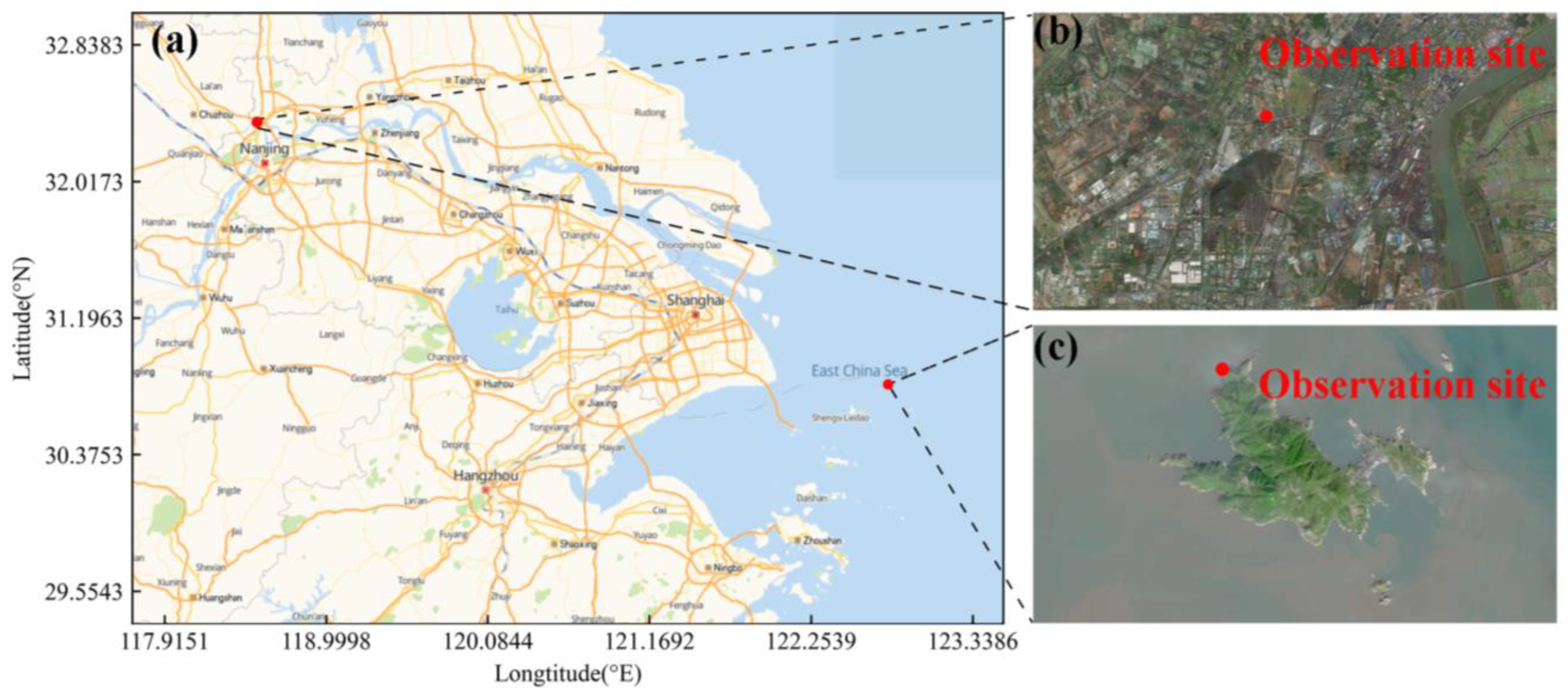
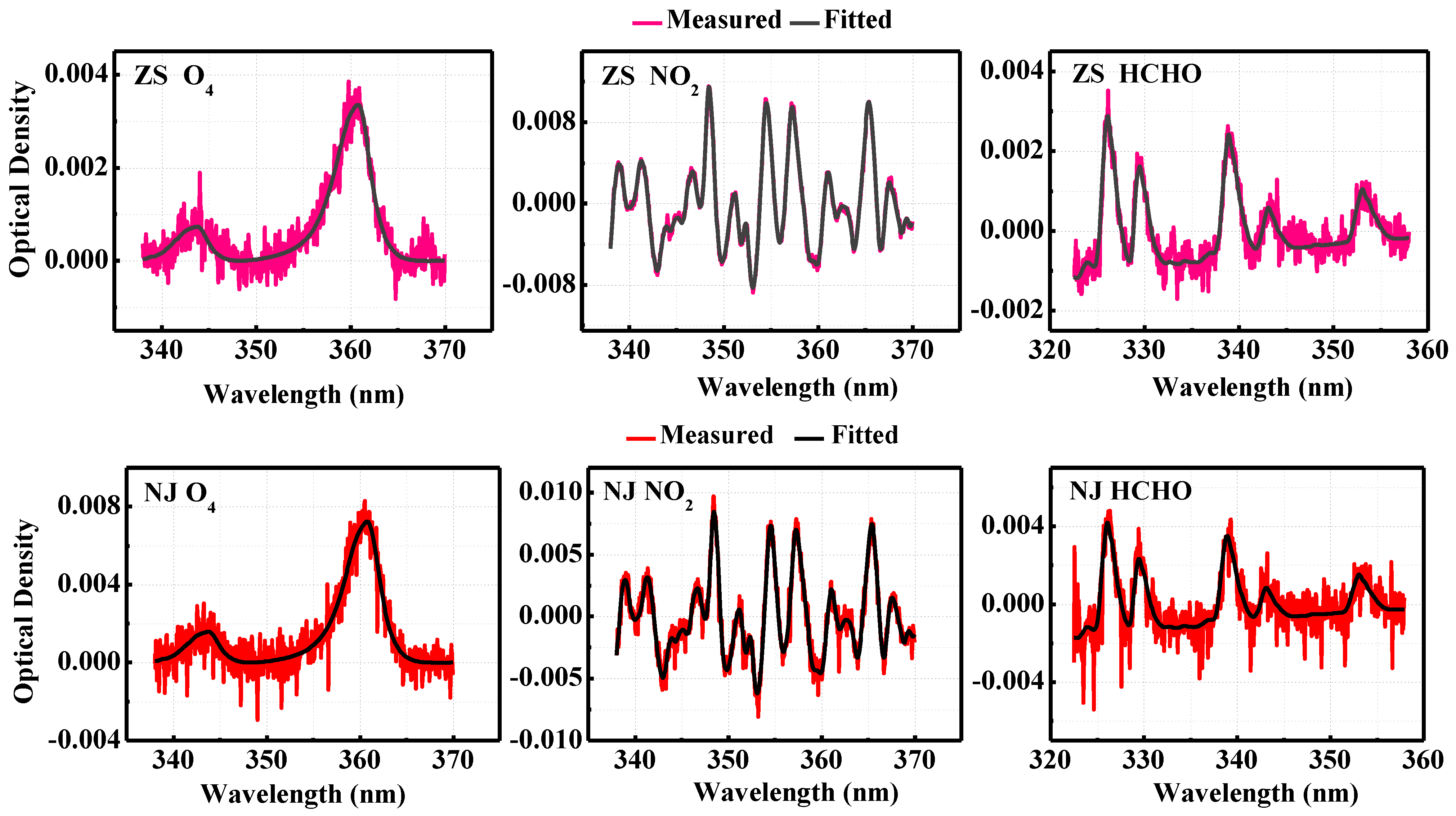
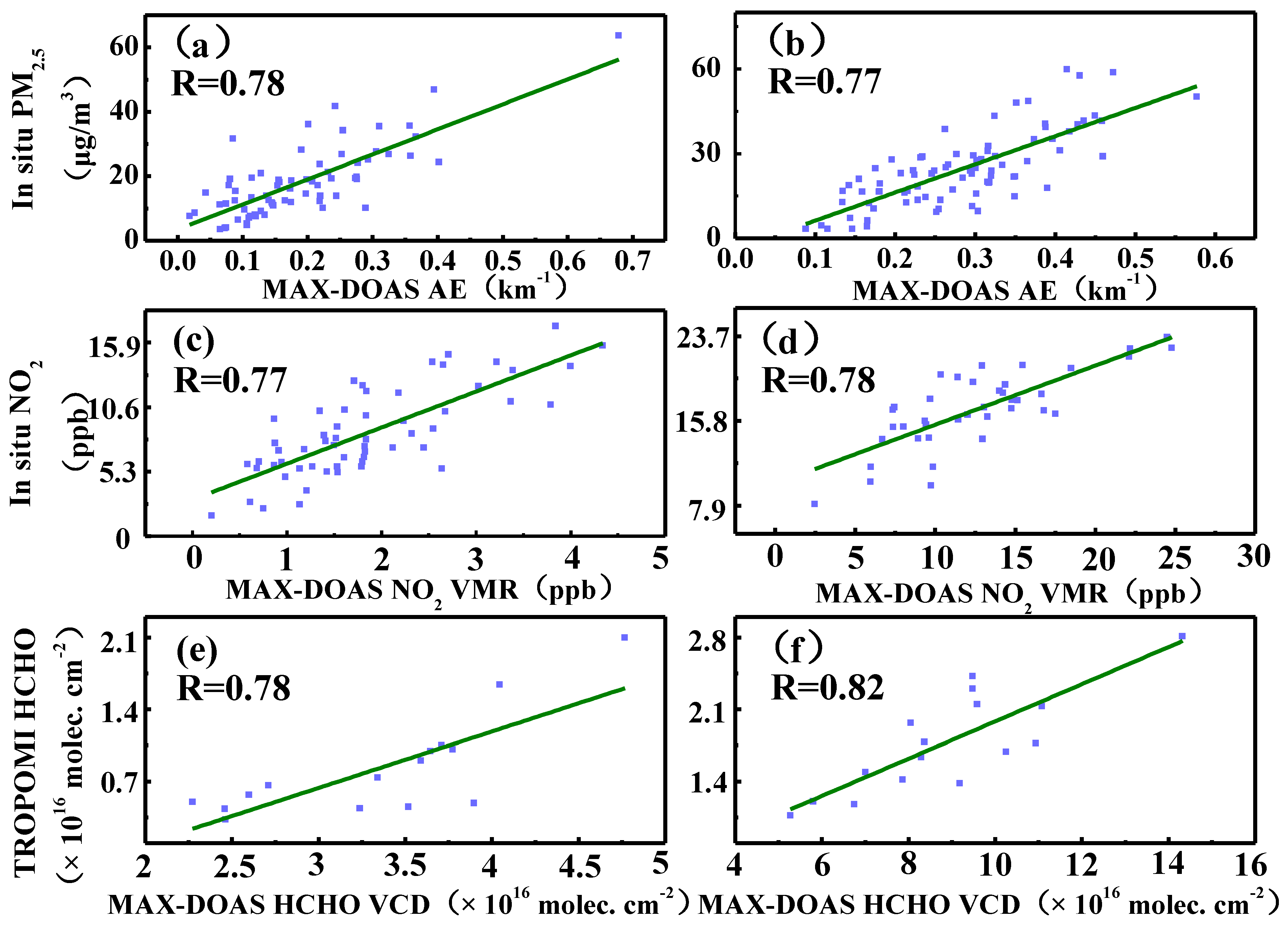
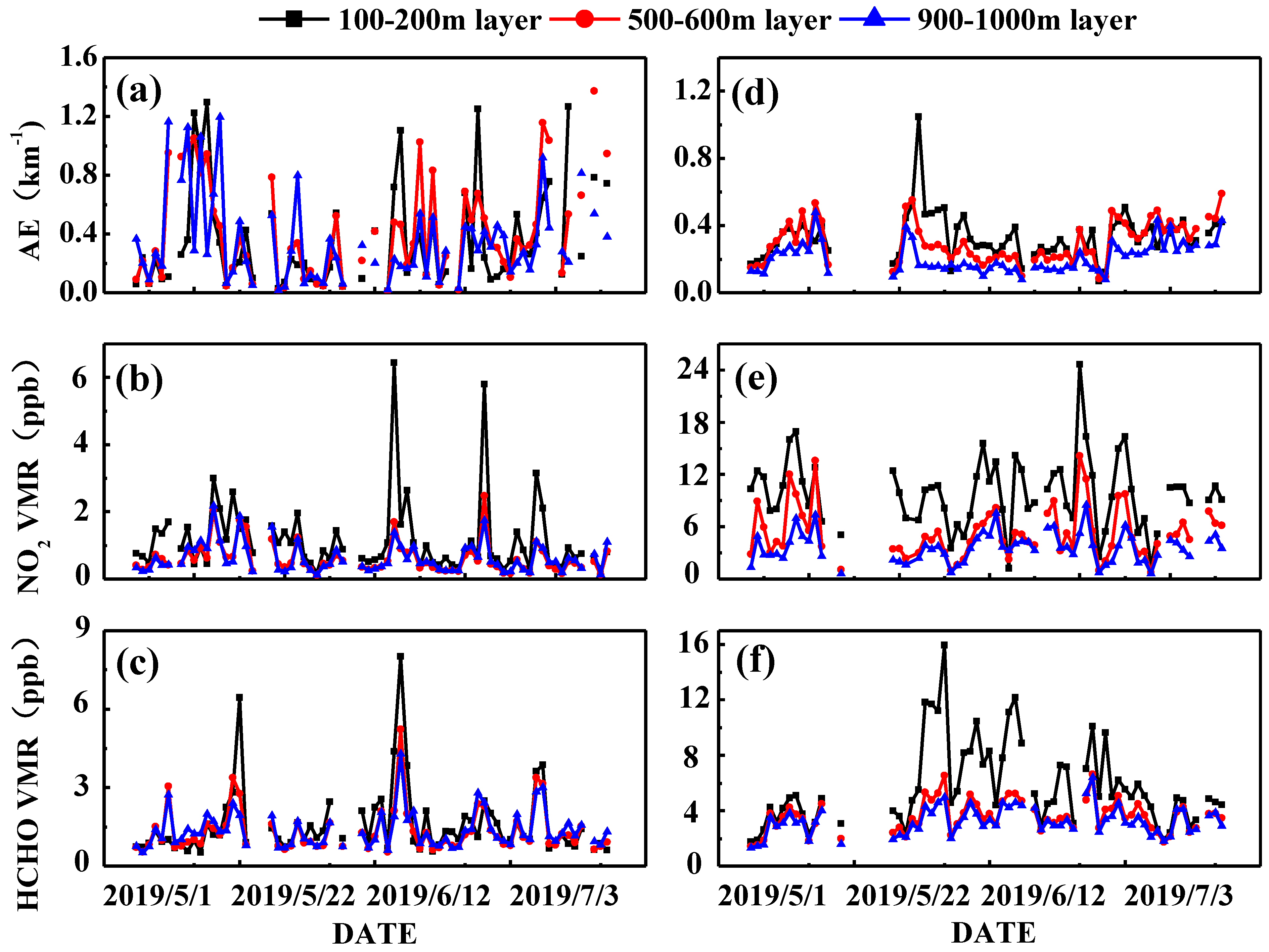
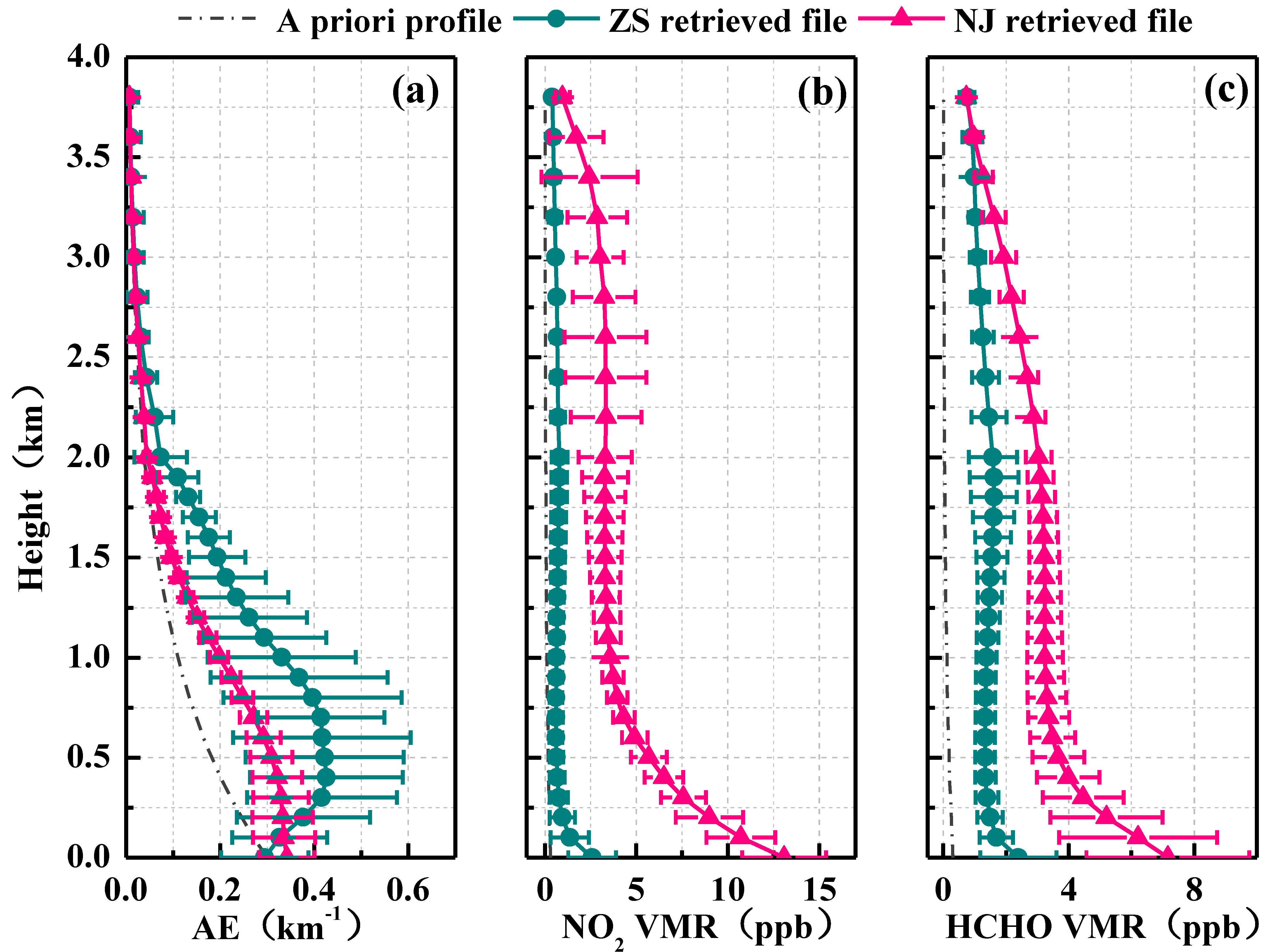
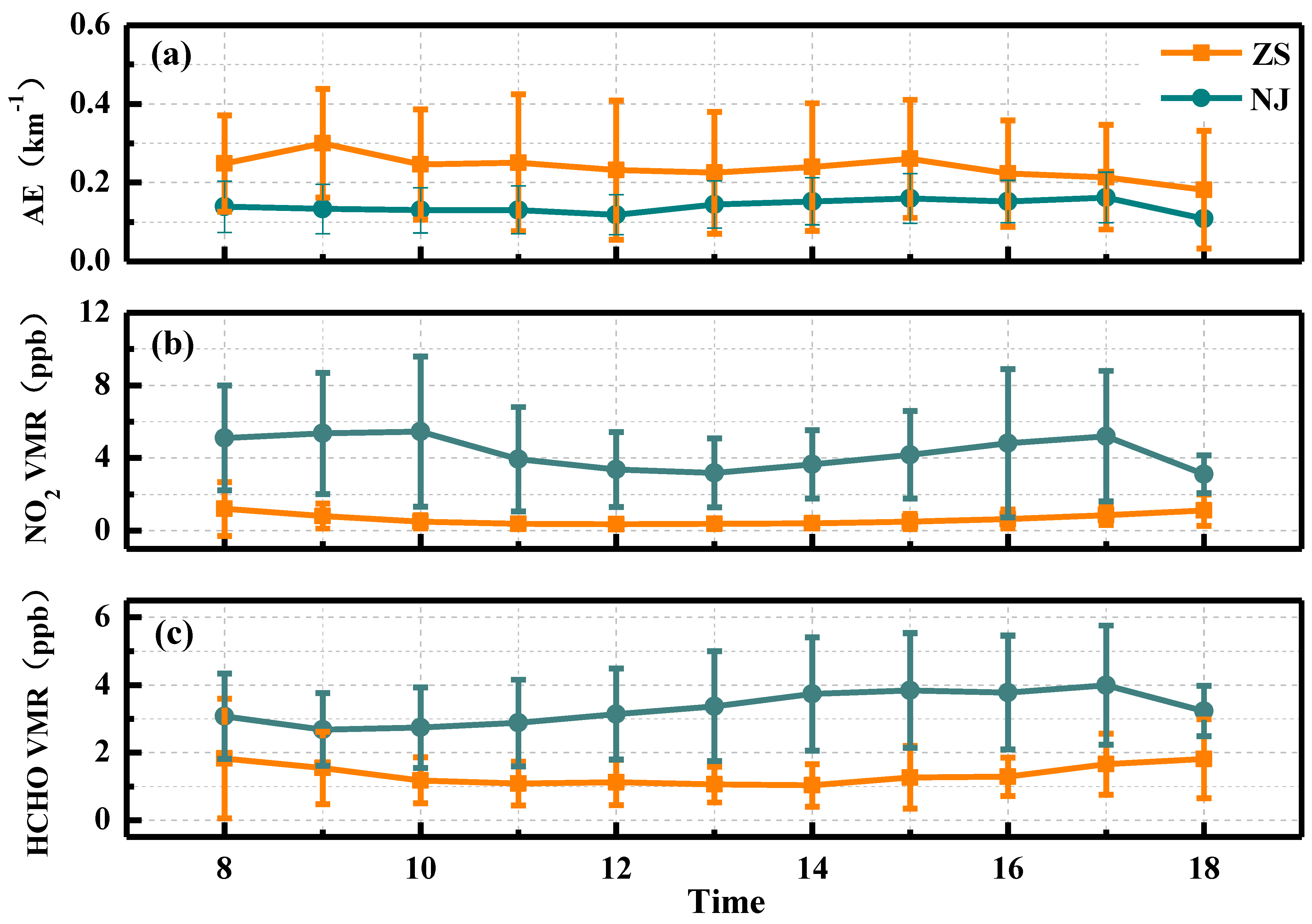
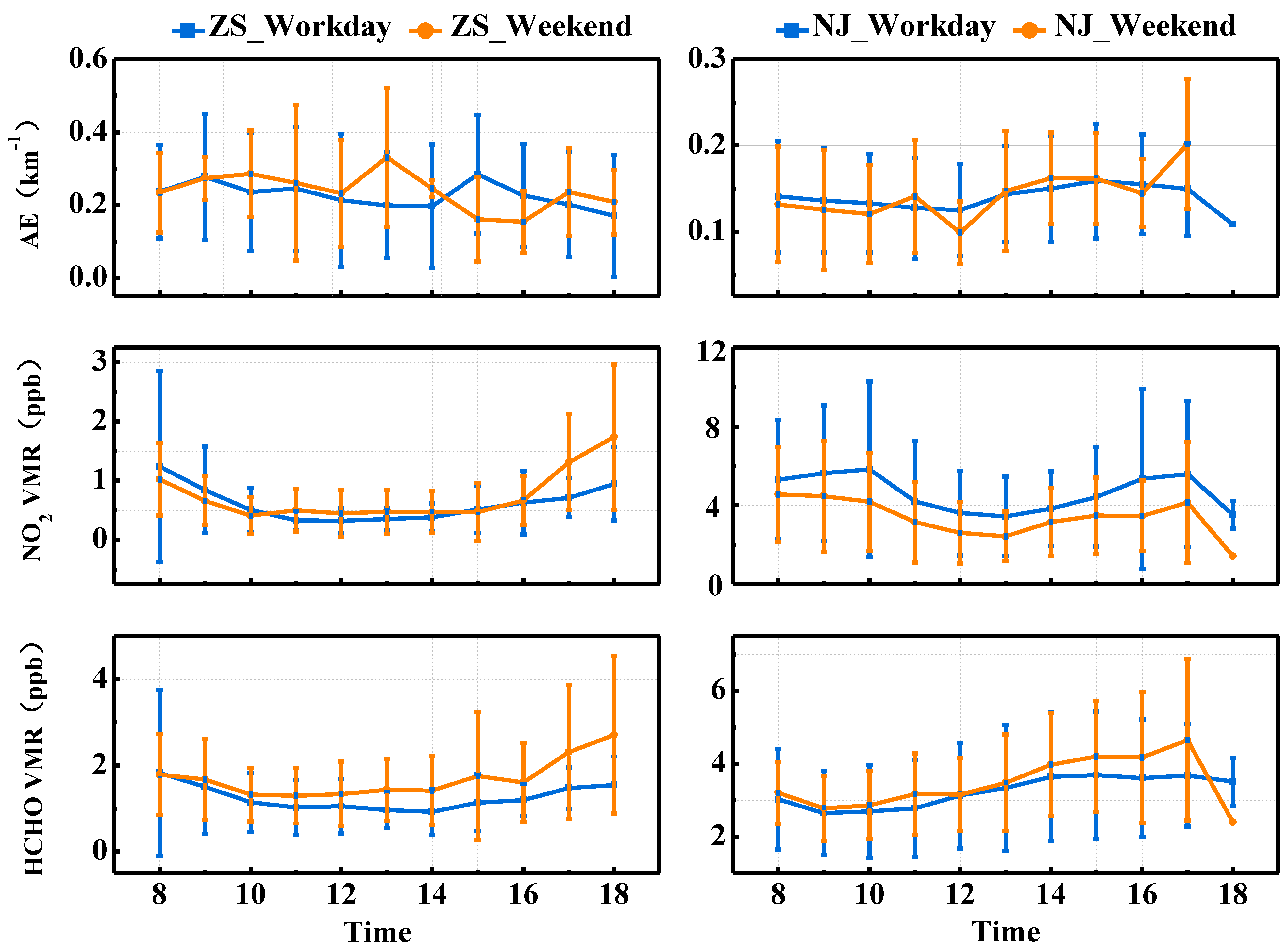


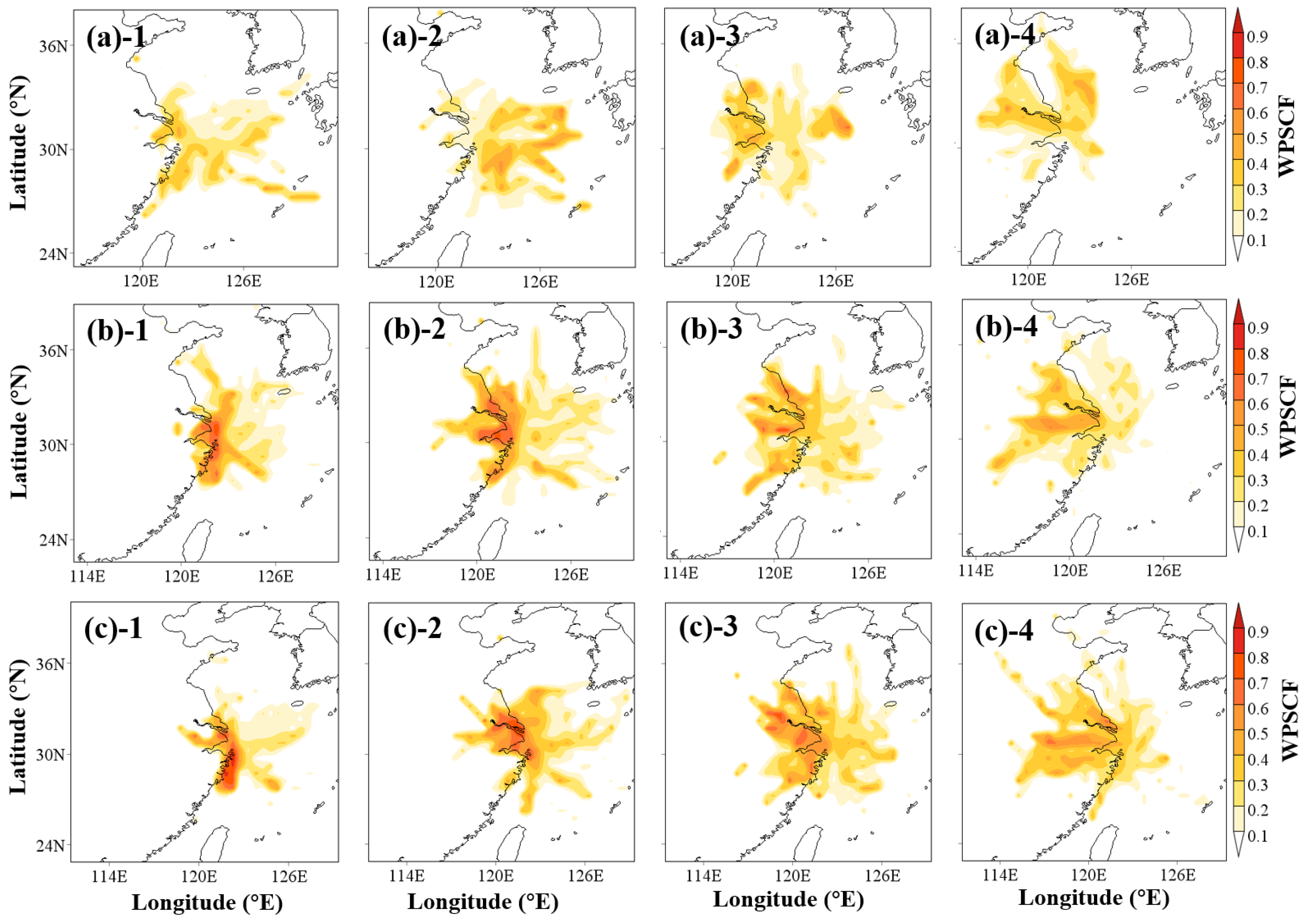
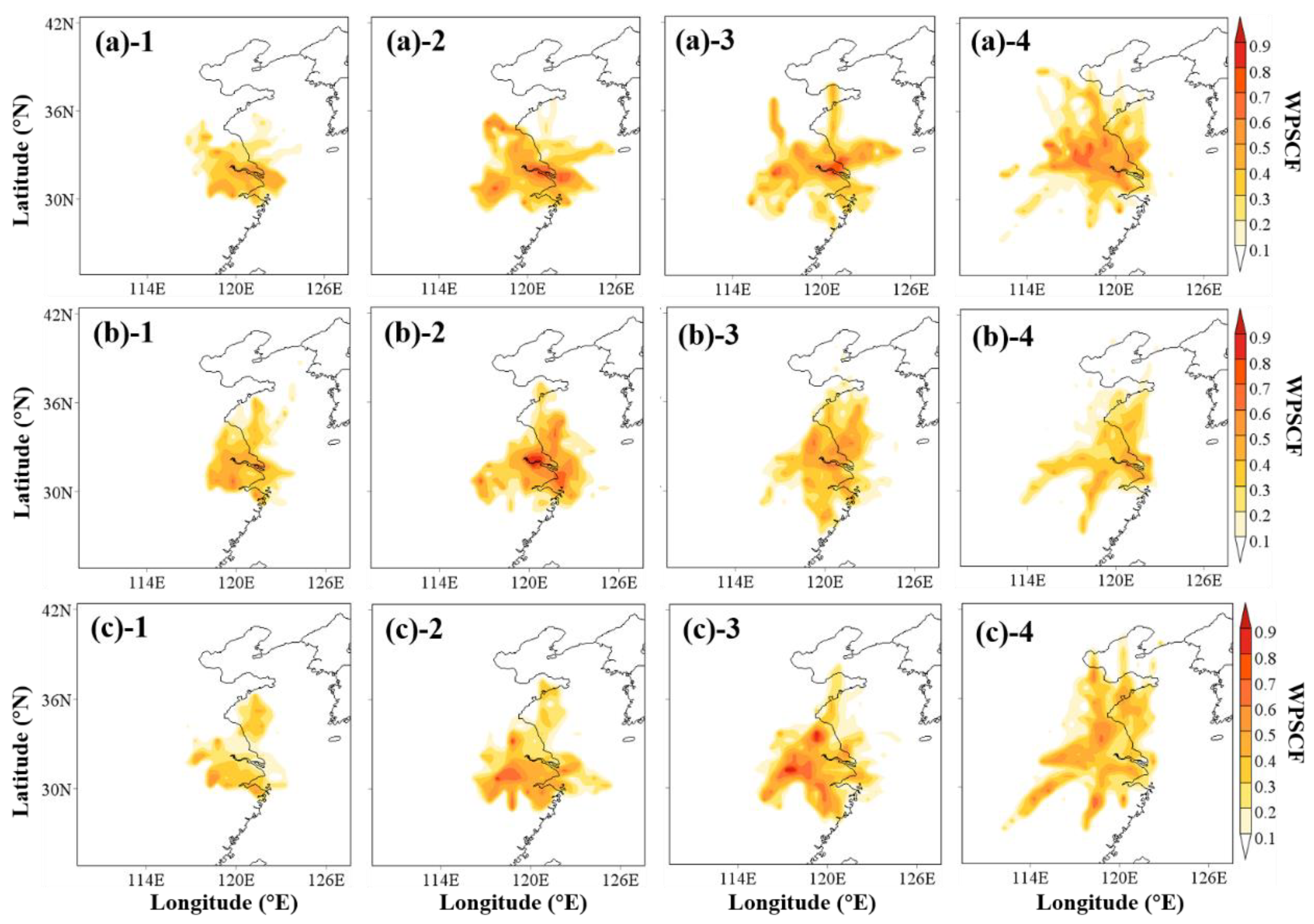
| Parameter | Data Source | Fitting Interval (nm) | |
|---|---|---|---|
| O4/NO2 | HCHO | ||
| Wavelength range | 338–370 | 322.5–358 | |
| NO2 | 298 K, I0 correction (SCD of 1017 molecules cm−2) [29] | √ | √ |
| NO2 | 220 K, I0 correction (SCD of 1017 molecules cm−2) [29] | √ | √ |
| O3 | 223 K, I0 correction (SCD of 1020 molecules cm−2) [30] | √ | √ |
| O3 | 243 K, I0 correction (SCD of 1020 molecules cm−2) [30] | √ | √ |
| O4 | 293 K [31] | √ | √ |
| BrO | 223 K [32] | √ | √ |
| H2O | 296 K, HITEMP [33] | √ | × |
| HCHO | 297 K [34] | √ | √ |
| Ring | Calculated with QDOAS [35] | √ | √ |
| Wavelength calibration | A high-resolution solar reference spectrum (SAO2010 solar spectra) [36] | √ | √ |
| Polynomial degree | Order 3 | Order 5 | |
| Intensity offset | Constant | Constant | |
| ZS_NO2 | ZS_HCHO | ZS_AE | |
|---|---|---|---|
| ZS_NO2 | 1 | ||
| ZS_HCHO | 0.98 ** | 1 | |
| ZS_AE | −0.19 | −0.19 | 1 |
| ZS_T | 0.14 | 0.18 | −0.74 ** |
| ZS_RH | 0.65 * | 0.64 * | 0.19 |
| ZS_WD | 0.116 | 0.04 | 0.74 ** |
| ZS_WS | −0.22 | −0.25 | 0.35 |
| NJ_NO2 | NJ_HCHO | NJ_AE | |
|---|---|---|---|
| NJ_NO2 | 1 | ||
| NJ_HCHO | −0.16 | 1 | |
| NJ_AE | 0.34 | 0.73 * | 1 |
| NJ_T | 0.38 | −0.71 * | −0.18 |
| NJ_RH | 0.65 * | −0.83 ** | −0.35 |
| NJ_WD | −0.45 | 0.81 ** | 0.29 |
| NJ_WS | −0.72 * | 0.70 * | 0.19 |
Disclaimer/Publisher’s Note: The statements, opinions and data contained in all publications are solely those of the individual author(s) and contributor(s) and not of MDPI and/or the editor(s). MDPI and/or the editor(s) disclaim responsibility for any injury to people or property resulting from any ideas, methods, instructions or products referred to in the content. |
© 2023 by the authors. Licensee MDPI, Basel, Switzerland. This article is an open access article distributed under the terms and conditions of the Creative Commons Attribution (CC BY) license (https://creativecommons.org/licenses/by/4.0/).
Share and Cite
Ou, J.; Hu, Q.; Xing, C.; Zhu, Y.; Feng, J.; Wang, X.; Ji, X.; Lin, H.; Yin, H.; Liu, C. Differences in the Vertical Distribution of Aerosols, Nitrogen Dioxide, and Formaldehyde between Islands and Inland Areas: A Case Study in the Yangtze River Delta of China. Remote Sens. 2023, 15, 5475. https://doi.org/10.3390/rs15235475
Ou J, Hu Q, Xing C, Zhu Y, Feng J, Wang X, Ji X, Lin H, Yin H, Liu C. Differences in the Vertical Distribution of Aerosols, Nitrogen Dioxide, and Formaldehyde between Islands and Inland Areas: A Case Study in the Yangtze River Delta of China. Remote Sensing. 2023; 15(23):5475. https://doi.org/10.3390/rs15235475
Chicago/Turabian StyleOu, Jinping, Qihou Hu, Chengzhi Xing, Yizhi Zhu, Jiaxuan Feng, Xinqi Wang, Xiangguang Ji, Hua Lin, Hao Yin, and Cheng Liu. 2023. "Differences in the Vertical Distribution of Aerosols, Nitrogen Dioxide, and Formaldehyde between Islands and Inland Areas: A Case Study in the Yangtze River Delta of China" Remote Sensing 15, no. 23: 5475. https://doi.org/10.3390/rs15235475
APA StyleOu, J., Hu, Q., Xing, C., Zhu, Y., Feng, J., Wang, X., Ji, X., Lin, H., Yin, H., & Liu, C. (2023). Differences in the Vertical Distribution of Aerosols, Nitrogen Dioxide, and Formaldehyde between Islands and Inland Areas: A Case Study in the Yangtze River Delta of China. Remote Sensing, 15(23), 5475. https://doi.org/10.3390/rs15235475







